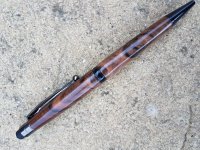I have spent all day trying to put a finish on a Macassar Ebony pen blank.
I Sanded to 600 grit and cleaned with Meth Spirits until the cloth I was applying it with stopped coming back black. I then put sanding sealer on, around 6 or 7 coats, until it looked even.
I then tried applying CA, for whatever reason it just would not take, it was like curdled milk. I tried again (using the same blank) after sanding back to the wood and put a tiny bit of CA on only for the same thing to happen, I rinsed and repeated for the 3rd time and it happened again. I will try it for the fourth time tomorrow and if no joy I will move on to a different wood on a new blank.
The CA is well inside it's best before date as is the sanding sealer. Could it be the oils from the wood reacting with the CA that is the problem?
I Sanded to 600 grit and cleaned with Meth Spirits until the cloth I was applying it with stopped coming back black. I then put sanding sealer on, around 6 or 7 coats, until it looked even.
I then tried applying CA, for whatever reason it just would not take, it was like curdled milk. I tried again (using the same blank) after sanding back to the wood and put a tiny bit of CA on only for the same thing to happen, I rinsed and repeated for the 3rd time and it happened again. I will try it for the fourth time tomorrow and if no joy I will move on to a different wood on a new blank.
The CA is well inside it's best before date as is the sanding sealer. Could it be the oils from the wood reacting with the CA that is the problem?



